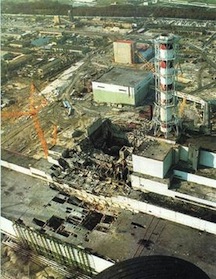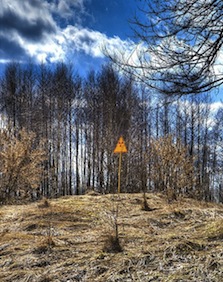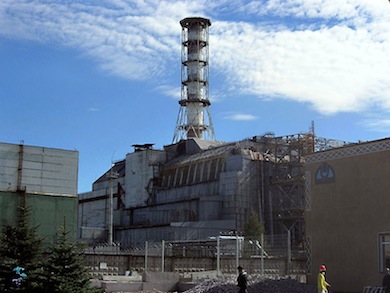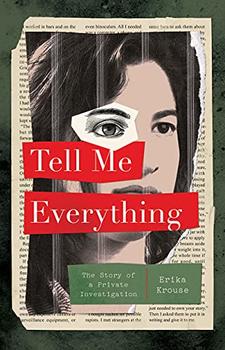Summary | Excerpt | Reviews | Beyond the Book | Read-Alikes | Genres & Themes | Author Bio

This article relates to All That Is Solid Melts into Air
In All That Is Solid Melts Into Air, the Chernobyl disaster acts as the primary backdrop against which the story unfolds. Darragh McKeon describes the accident and the horrific aftermath in moving detail.
 The disaster took place more than twenty-five years ago, on April 26, 1986, Situated about 88 miles north of Kiev in Ukraine, which was then part of the Soviet Union, the nuclear plant comprised four reactors all based on the Soviet designed RBMK-1000 model. In this model, enriched uranium is used to heat water, which is then used to drive turbines and generate electricity. In most nuclear reactors, water is also used as a gauge to control the core's reactivity. This means that as the core heats up, it produces steam or bubbles in the water, and the system is designed to automatically temper things down and not let the nuclear reactions get out of hand. In this design, however, as more steam is produced, things get even more reactive creating a dangerous self-sustaining loop – a flawed model from the start.
The disaster took place more than twenty-five years ago, on April 26, 1986, Situated about 88 miles north of Kiev in Ukraine, which was then part of the Soviet Union, the nuclear plant comprised four reactors all based on the Soviet designed RBMK-1000 model. In this model, enriched uranium is used to heat water, which is then used to drive turbines and generate electricity. In most nuclear reactors, water is also used as a gauge to control the core's reactivity. This means that as the core heats up, it produces steam or bubbles in the water, and the system is designed to automatically temper things down and not let the nuclear reactions get out of hand. In this design, however, as more steam is produced, things get even more reactive creating a dangerous self-sustaining loop – a flawed model from the start.
The accident destroyed reactor four. During the night of the accident engineers performing what were, supposedly, routine tests switched off automatic shutdown mechanisms. A random high demand for power lead to a surge of production and when the cooling rods were eventually dunked in the water coolant, the resultant steam increased the reactivity in the core creating a violent reaction and an explosion that eventually spewed tons of radioactive material into the air - the graphite rods also burned along with other components of reactor four which was still operational at the time.
 The (approximately) 49,000 residents of Pripyat, a purpose-built city to support the plant, were evacuated, but not before substantial damage had already been done and the radiation cloud spread to neighboring Belarus and Europe. The Soviet Union, in fact, kept the disaster under wraps until a power plant in Sweden detected unusually high levels of radiation in the surrounding atmosphere, which was confirmed by other European sources as well. Twenty-eight emergency workers died within three months of the accident, and hundreds more developed thyroid cancer from the radiation. The Union of Concerned Scientists estimates that there will be 50,000 excess cancer cases across Europe as a result of the disaster, half of which will lead to premature death. Wildlife and forests were severely damaged and became known as "Red Forests" because the trees turned a bright ginger color. These days wildlife is slowly coming back although growth in the immediate neighborhood the plant is still stunted.
The (approximately) 49,000 residents of Pripyat, a purpose-built city to support the plant, were evacuated, but not before substantial damage had already been done and the radiation cloud spread to neighboring Belarus and Europe. The Soviet Union, in fact, kept the disaster under wraps until a power plant in Sweden detected unusually high levels of radiation in the surrounding atmosphere, which was confirmed by other European sources as well. Twenty-eight emergency workers died within three months of the accident, and hundreds more developed thyroid cancer from the radiation. The Union of Concerned Scientists estimates that there will be 50,000 excess cancer cases across Europe as a result of the disaster, half of which will lead to premature death. Wildlife and forests were severely damaged and became known as "Red Forests" because the trees turned a bright ginger color. These days wildlife is slowly coming back although growth in the immediate neighborhood the plant is still stunted.
 The reactor was eventually sealed with a makeshift concrete sarcophagus, which has been shaky in the protection it offers. In a multi-national effort, a huge arch sheathed in stainless steel is being constructed. It will cover the sarcophagus and the entire reactor unit, and will contain any radioactive dust that would escape if the structure eventually collapses. The arch, which covers acres of stainless steel and has a complex engineering structure, is expected to cost $1.5 billion when finally done - the project is expected to be completed in 2017. A circular exclusion zone with a radius of about 19 miles still exists encompassing an area of about 1000 sq miles, even while some tourists come to take a peek at the worst civilian nuclear disaster in history.
The reactor was eventually sealed with a makeshift concrete sarcophagus, which has been shaky in the protection it offers. In a multi-national effort, a huge arch sheathed in stainless steel is being constructed. It will cover the sarcophagus and the entire reactor unit, and will contain any radioactive dust that would escape if the structure eventually collapses. The arch, which covers acres of stainless steel and has a complex engineering structure, is expected to cost $1.5 billion when finally done - the project is expected to be completed in 2017. A circular exclusion zone with a radius of about 19 miles still exists encompassing an area of about 1000 sq miles, even while some tourists come to take a peek at the worst civilian nuclear disaster in history.
Chernobyl disaster, courtesy of the Soviet Government
The Red Forest, courtesy of Timm Suess
Chernobyl with the sarcophagus container, courtesy of Carl Montgomery
Filed under People, Eras & Events
![]() This article relates to All That Is Solid Melts into Air.
It first ran in the May 21, 2014
issue of BookBrowse Recommends.
This article relates to All That Is Solid Melts into Air.
It first ran in the May 21, 2014
issue of BookBrowse Recommends.




The good writer, the great writer, has what I have called the three S's: The power to see, to sense, and to say. ...
Click Here to find out who said this, as well as discovering other famous literary quotes!
Your guide toexceptional books
BookBrowse seeks out and recommends the best in contemporary fiction and nonfiction—books that not only engage and entertain but also deepen our understanding of ourselves and the world around us.